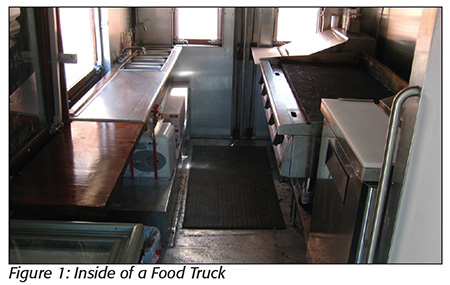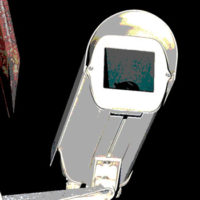The popularity of mobile food trucks has exploded across the nation due to the many food shows on national TV such as the Great Food Truck Race, the 2014 hit movie Chef and the Great Recession of 2008. These gourmet restaurants on wheels have revolutionized urban cuisine and provided a diversity of food and flavors to the communities and customers they serve.
Food trucks have the same opportunities and challenges as brick-and-mortar restaurants in serving safe and delicious food at a reasonable price. Even though food trucks and restaurants conduct business in a similar manner, food trucks operate with limited storage capacity, preparation/cooking area and infrastructure to support handwashing and sanitizing of utensils and equipment.
 This limited capacity and infrastructure (Figure 1) presents operational challenges in preparing, cooking and serving their customers, but also food safety concerns involving active managerial control of foodborne illness risk factors, including employee health and hygiene, adequate cooking, proper holding, protection from contaminated equipment and approved food sources.
This limited capacity and infrastructure (Figure 1) presents operational challenges in preparing, cooking and serving their customers, but also food safety concerns involving active managerial control of foodborne illness risk factors, including employee health and hygiene, adequate cooking, proper holding, protection from contaminated equipment and approved food sources.
For these reasons, when working with established food truck owners or people interested in starting a food truck business, I take a holistic view on how to help them understand and develop a solid business plan, which includes best practices for food safety and quality.
Starting the Business
To start or grow a food truck business, the owner must develop a business plan. This plan must include: type of business ownership, liability insurance, credit and financing, marketing and market research, record keeping and management, cash flow and governmental compliance. The development of the business plan will help the owner understand the potential rewards and challenges of operating a small business and allow him or her to decide if this endeavor is financially feasible.
The Menu. After the business plan has been established, the next step is the development of the business concept, which includes the menu. Major decisions about the food truck business will revolve around the menu, including the truck size, equipment needed, capacity of the infrastructure and branding/marketing of the product. The menu should reflect three or four signature items that can be quickly prepared and served safely while providing a culinary treat to the patron.
I worked with a client who developed a menu of six signature dishes, two of which were vegetarian, one pork, two seafood and one beef dish, all using local products with most ingredients supplied directly from local farmers. Sourcing the food was challenging but could be accomplished. All of the recipes required extensive preparation and cooking time. This complicated from-scratch menu was developed and perfected in a large commercial kitchen, but when the chef tried to prepare this same menu in a confined food truck, it did not result in an executable menu. The complicated cooking/preparation process increased food safety risks through inadequate storage for all ingredients, cross-contamination through limited preparation/cooking space and possible undercooking of raw ingredients due to the demand of customers to be served foods purchased in an appropriate time. (Food truck customers are not happy if they have to wait longer than 10 minutes for their orders.) This demonstrated how the menu must be realistic for the size, infrastructure and equipment available on a food truck. Many recipes do not translate into instant success, as this ambitious chef/owner found out.
The Equipment. Many of my clients come to me after they have purchased a used food truck that is fully equipped. However, the size, infrastructure and equipment do not match the original menu they anticipated serving. It is at this point that some important decisions need to be made: invest in changing equipment to fit the desired menu or change the menu to fit the existing infrastructure of the truck.
Just as in a brick-and-mortar kitchen, food truck equipment must be NSF/UL approved. Purchasing new or used equipment is dependent upon the condition and frequency of use as well as being easily cleanable. The power source for the equipment on food trucks is usually a combination of electric and propane gas.
The Truck Itself. After the business plan is developed and the menu is established, then the next important factors to consider are: the size of truck, its mechanical condition, the infrastructure and type of equipment needed to prepare the menu established. I cannot emphasize enough the importance of a fully developed menu and business plan/concept before purchasing a food truck. The floor plan and equipment specifications are based on the menu to achieve best practices in food quality and food safety.
Choosing the right truck, whether new or used, is essential to the success of the business. The food truck must be the right size and dimensions to house the equipment needed to store, prepare and serve the menu. It also needs to be large enough to allow the necessary number of employees to prepare and serve customers. Another important consideration is the working mechanical condition of the truck itself. What type of warranty does it come with and how much are preventive maintenance checkups? How often will the truck be used for business (days and hours of operation per week)?
The infrastructure of the food truck includes: freshwater tank, water heater, wastewater tank, backflow prevention devices, ventilation hood, propane gas and power sources of electric and generators. The capacity of the freshwater tank and water heater depends upon the processes and procedures in preparing the menu, and the wastewater tank should always be five gallons larger than the freshwater tank. Generators are an essential investment for a food truck, allowing it to be fully operational when electrical hookups are not accessible.
Licensing
Before the food truck can open for business, it will need to be licensed by the state or local regulatory agency. Each state and local health jurisdiction has different requirements for plan approval and licensing. Other regulatory and zoning requirements differ from city to city, county to county and state to state. Since the movie Chef in early 2014, many of my clients think they can buy a food truck and travel across the nation, seeing the sights while serving food and making lots of money without consideration of local regulatory requirements. Hollywood has a way of making this form of entrepreneurship look easy and glamorous. Obviously, this is not the case.
All food truck businesses should have written Standard Operating Procedures (SOPs). The SOPs must address both the infrastructure demands and the control of foodborne illness risk factors. There are several SOPs that must be in place that are very different from the SOPs typical for brick-and-mortar food establishments. Examples would be:
• Proper filling of the freshwater tank before each use
• Proper wastewater discharge after each use
• Power source availability to maintain operation of lighting and equipment at location
• Proximity of truck to restroom facilities at location
• Working conditions of food equipment when truck is in transit
Some state and local health jurisdictions require mobile food trucks to operate from a licensed foodservice commissary. The commissary becomes the business address and base of operations for the food truck. In Ohio, a food truck is not required to operate from a commissary. However, I highly recommend to all current food truck owners and those interested in starting a food truck business to use a commissary.
A typical commissary provides additional dry and cold storage, food preparation areas that include proper food prep sinks, freshwater supply, dump station for wastewater, dumpsters for both trash and recyclable materials, and ware washing machines and/or three-compartment sinks. A commissary may also provide a propane gas filling station, a licensed foodservice kitchen (to use for catering events or food delivery opportunities) and other services like bagged ice vending. Other value-added amenities include networking with other food truck owners and negotiating from vendors of food and food product businesses.
The use of a commissary allows a food truck business to carry more inventory and store extra utensils. The commissary becomes the brick-and-mortar structure of the food truck and allows the owner to focus more on business opportunities and sales.
Making It Work
Just like brick-and-mortar restaurants, mobile food trucks must be able to forecast business sales as much as possible. Forecasting allows the owner to determine staffing levels and how much food to buy and prepare, reducing waste. Accurate forecasting increases the profitability of the food truck business and helps control the risk factors contributing to foodborne illnesses. Successful food truck owners are able to forecast business opportunities at least 2–3 months in advance or for the entire season of operation.
The food truck industry continues to grow both nationally and internationally. The momentum behind this growth is both from entrepreneurs realizing their dream to open their own business and established brick and mortars looking to expand their brand or develop a new concept. Opening a successful food truck business is determined by developing a proper business plan, business concept, menu, truck size and infrastructure, SOPs and forecasting. The business of “taking food to the people” is not new, but the diversity of the food served has certainly changed the landscape of the foodservice industry.
Robert J. Kramer, R.S./REHS, has over 42 years’ experience in food safety. He retired from the Columbus (OH) Public Health Department after 35 years and is now director of food safety and services for the Food Fort at the Economic and Community Institute in Columbus.




